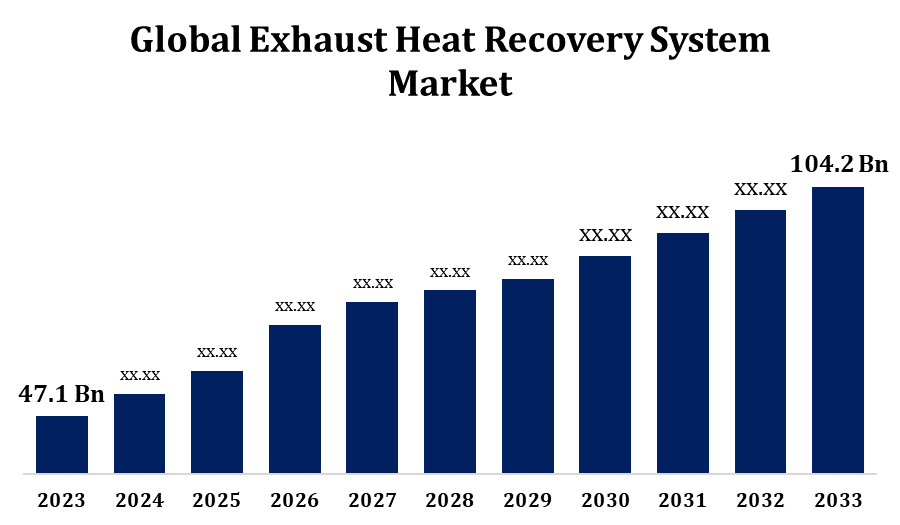Global Exhaust Heat Recovery System Market Size, Share, and COVID-19 Impact Analysis, By Technology (Turbocharger, Organic Rankine Cycle (ORC), Thermoelectric Generator (TEG)), By Vehicle Type (Passenger Cars, Commercial Vehicles), By Component (EGR Valve, EGR Cooler, Turbocharger), and By Region (North America, Europe, Asia-Pacific, Latin America, Middle East, and Africa), Analysis and Forecast 2023 - 2033
Industry: Automotive & TransportationGlobal Exhaust Heat Recovery System Market Insights Forecasts to 2033
- The Exhaust Heat Recovery System Market Size Was Valued at USD 47.1 Billion in 2023.
- The Market Size is Growing at a CAGR of 8.26% from 2023 to 2033.
- The global Exhaust Heat Recovery System Market Size is Expected to reach USD 104.2 Billion by 2033.
- Asia Pacific is Expected to Grow the fastest during the Forecast period.

Get more details on this report -
The Global Exhaust Heat Recovery System Market Size is Expected to reach USD 104.2 Billion by 2033, at a CAGR of 8.26% during the Forecast period 2023 to 2033.
The Exhaust Heat Recovery System (EHRS) market is experiencing steady growth, driven by increasing demand for fuel-efficient vehicles and stringent emission regulations worldwide. These systems capture and reuse waste heat from vehicle exhaust, improving overall energy efficiency and reducing greenhouse gas emissions. Automotive manufacturers are integrating EHRS technologies in internal combustion engines and hybrid vehicles to meet evolving environmental standards. Additionally, advancements in thermoelectric materials and compact system designs are enhancing EHRS performance and adoption across various vehicle segments. The rising popularity of electric and hybrid vehicles, especially in regions like Europe, North America, and Asia-Pacific, further boosts market growth. Industrial applications in power generation and marine sectors are also contributing to the expansion of this market, making it a vital component in sustainable energy strategies.
Exhaust Heat Recovery System Market Value Chain Analysis
The value chain of the Exhaust Heat Recovery System (EHRS) market involves multiple key stages, beginning with raw material suppliers providing essential components such as heat exchangers, thermoelectric materials, and sensors. These materials are then processed by component manufacturers who design and produce EHRS units. System integrators play a crucial role in assembling and testing these systems for compatibility with various vehicle or industrial platforms. Original Equipment Manufacturers (OEMs) integrate EHRS into engines or energy systems, ensuring compliance with emission norms. Distributors and suppliers facilitate the movement of EHRS units to end-users, including automotive, marine, and power generation industries. Finally, after-sales services, including maintenance and technical support, ensure long-term functionality. Collaboration across the value chain enhances innovation, cost-efficiency, and sustainable energy utilization.
Exhaust Heat Recovery System Market Opportunity Analysis
The Exhaust Heat Recovery System (EHRS) market presents significant growth opportunities driven by increasing global emphasis on energy efficiency and emission reduction. As governments tighten fuel economy and CO2 regulations, especially in the automotive and industrial sectors, demand for EHRS is rising. Automakers are integrating these systems to enhance fuel efficiency and meet sustainability goals. Additionally, the growth of hybrid and electric vehicles, which benefit from thermal energy management, boosts market potential. Emerging economies are also adopting advanced technologies to reduce energy loss and improve performance across manufacturing and power generation sectors. With continuous innovations and rising environmental awareness, the EHRS market is poised for robust expansion, offering attractive opportunities for system manufacturers, component suppliers, and OEMs over the next decade.
Global Exhaust Heat Recovery System Market Report Coverage
| Report Coverage | Details |
|---|---|
| Base Year: | 2023 |
| Market Size in 2023: | USD 47.1 Billion |
| Forecast Period: | 2023-2033 |
| Forecast Period CAGR 2023-2033 : | 8.26% |
| 2033 Value Projection: | USD 104.2 Billion |
| Historical Data for: | 2019-2022 |
| No. of Pages: | 240 |
| Tables, Charts & Figures: | 115 |
| Segments covered: | By Technology, By Vehicle Type, By Component, By Region and COVID-19 Impact Analysis |
| Companies covered:: | Faurecia (France), Mahle (Germany), Continental (Germany), Denso (Japan), Valeo (France), Dana (US), Calsonic Kansei (Japan), Delphi Technologies (UK), Mitsubishi Electric (Japan), Hitachi Ltd. (Japan), Bosal (Belgium), Tenneco Inc. (US), Borgwarner Inc. (US) and others key players. |
| Pitfalls & Challenges: | COVID-19 Empact, Challenges, Future, Growth, & Analysis |
Get more details on this report -
Market Dynamics
Exhaust Heat Recovery System Market Dynamics
Strict emission regulations are driving market growth
Strict emission regulations are a key driver of growth in the Exhaust Heat Recovery System (EHRS) market. Governments worldwide are enforcing tighter limits on greenhouse gas emissions, compelling industries especially automotive, marine, and power generation to adopt energy-efficient solutions. EHRS technologies help capture and reuse waste heat, thereby improving fuel efficiency and reducing carbon footprints. Automakers are increasingly integrating these systems to comply with fuel economy standards and environmental regulations. Additionally, the shift toward hybrid and electric vehicles, which benefit from enhanced thermal management, further accelerates EHRS adoption. Industrial sectors are also embracing these systems to optimize energy use and meet sustainability targets. As regulatory pressures intensify, demand for EHRS solutions is expected to surge, creating substantial opportunities for manufacturers and suppliers across global markets.
Restraints & Challenges
The Exhaust Heat Recovery System (EHRS) market faces several challenges that could hinder its growth. High initial costs and complex integration processes act as significant barriers, especially for small and medium-sized manufacturers. These systems require advanced materials and precision engineering, leading to increased production and maintenance costs. Additionally, retrofitting EHRS into existing vehicle or industrial infrastructures can be technically challenging and economically unfeasible. Limited awareness about the long-term cost and energy benefits in emerging markets further restricts adoption. Moreover, the rapid shift toward fully electric vehicles, which generate less exhaust heat, may reduce demand for traditional EHRS in the automotive sector. Regulatory differences across regions and the need for continuous innovation to improve system efficiency also present ongoing challenges for market players.
Regional Forecasts
North America Market Statistics

Get more details on this report -
North America is anticipated to dominate the Exhaust Heat Recovery System Market from 2023 to 2033. The United States and Canada are leading the region with strong government support for emission reduction initiatives and energy conservation programs. Automotive manufacturers are investing in EHRS to comply with Corporate Average Fuel Economy (CAFE) standards, while industrial sectors adopt these systems to optimize energy use and reduce operational costs. The region’s robust research and development infrastructure supports innovation in thermal management technologies. Additionally, the growing adoption of hybrid and plug-in hybrid vehicles, which benefit from efficient heat recovery, further boosts market potential.
Asia Pacific Market Statistics
Asia Pacific is witnessing the fastest market growth between 2023 to 2033. China, India, Japan, and South Korea are implementing stricter emission norms and fuel efficiency standards, pushing industries and automakers to adopt advanced thermal management systems. The automotive sector, particularly with the rise in hybrid and electric vehicles, is a major contributor to EHRS demand as these systems help improve energy efficiency and reduce emissions. Additionally, expanding manufacturing activities and growing power generation needs support the adoption of EHRS in industrial applications. The region also benefits from lower production costs and a skilled labor force, encouraging technology development.
Segmentation Analysis
Insights by Technology
The turbochargers segment accounted for the largest market share over the forecast period 2023 to 2033. Turbochargers utilize exhaust gases to drive a turbine, which compresses intake air, thereby increasing engine power output and reducing emissions. This technology is widely adopted in both automotive and industrial applications due to its effectiveness in improving energy efficiency. The increasing demand for energy-efficient engines and the need to optimize atmospheric pollution levels are key factors propelling the growth of the turbocharger segment. Additionally, the integration of turbochargers in hybrid and electric vehicles is further boosting their adoption, as they contribute to improved battery performance and extended vehicle range.
Insights by Vehicle Type
The passenger cars segment accounted for the largest market share over the forecast period 2023 to 2033. Passenger vehicles constitute the largest portion of global vehicle sales, leading to widespread adoption of EHRS technologies such as Exhaust Gas Recirculation (EGR) and turbochargers to meet environmental standards and improve performance. The rise in hybrid and electric vehicles further amplifies this trend, as these vehicles benefit from advanced thermal management systems that enhance battery efficiency and extend driving range. Additionally, consumer demand for eco-friendly and cost-effective transportation solutions is encouraging automakers to integrate EHRS into passenger cars.
Insights by Component
The EGR Cooler segment accounted for the largest market share over the forecast period 2023 to 2033. EGR coolers reduce nitrogen oxide (NOx) emissions by lowering combustion temperatures, making them essential for compliance with environmental standards. Their application spans both diesel and gasoline engines, with notable adoption in diesel-powered commercial vehicles due to their effectiveness in emission control. Technological advancements have led to the development of tube and finned EGR coolers, offering enhanced heat transfer capabilities and cost-effectiveness. The integration of EGR coolers in hybrid and electric vehicles further underscores their importance in modern engine designs.
Recent Market Developments
- In June 2024, BorgWarner has introduced an enhanced version of its exhaust heat recovery system, featuring upgraded thermal management capabilities.
Competitive Landscape
Major players in the market
- Faurecia (France)
- Mahle (Germany)
- Continental (Germany)
- Denso (Japan)
- Valeo (France)
- Dana (US)
- Calsonic Kansei (Japan)
- Delphi Technologies (UK)
- Mitsubishi Electric (Japan)
- Hitachi Ltd. (Japan)
- Bosal (Belgium)
- Tenneco Inc. (US)
- Borgwarner Inc. (US)
Market Segmentation
This study forecasts revenue at global, regional, and country levels from 2023 to 2033.
Exhaust Heat Recovery System Market, Technology Analysis
- Turbocharger
- Organic Rankine Cycle (ORC)
- Thermoelectric Generator (TEG)
Exhaust Heat Recovery System Market, Vehicle Type Analysis
- Passenger Cars
- Commercial Vehicles
Exhaust Heat Recovery System Market, Component Analysis
- EGR Valve
- EGR Cooler
- Turbocharger
Exhaust Heat Recovery System Market, Regional Analysis
- North America
- US
- Canada
- Mexico
- Europe
- Germany
- Uk
- France
- Italy
- Spain
- Russia
- Rest of Europe
- Asia Pacific
- China
- Japan
- India
- South Korea
- Australia
- Rest of Asia Pacific
- South America
- Brazil
- Argentina
- Rest of South America
- Middle East & Africa
- UAE
- Saudi Arabia
- Qatar
- South Africa
- Rest of the Middle East & Africa
Frequently Asked Questions (FAQ)
-
1. What is the market size of the Exhaust Heat Recovery System Market?The global Exhaust Heat Recovery System Market is expected to grow from USD 47.1 billion in 2023 to USD 104.2 billion by 2033, at a CAGR of 8.26% during the forecast period 2023-2033.
-
2. Who are the key market players of the Exhaust Heat Recovery System Market?Some of the key market players of the market are Faurecia (France), Mahle (Germany), Continental (Germany), Denso (Japan), Valeo (France), Dana (US), Calsonic Kansei (Japan), Delphi Technologies (UK), Mitsubishi Electric (Japan), Hitachi Ltd. (Japan), Bosal (Belgium), Tenneco Inc. (US), Borgwarner Inc. (US).
-
3. Which segment holds the largest market share?The passenger cars segment holds the largest market share and is going to continue its dominance.
Need help to buy this report?